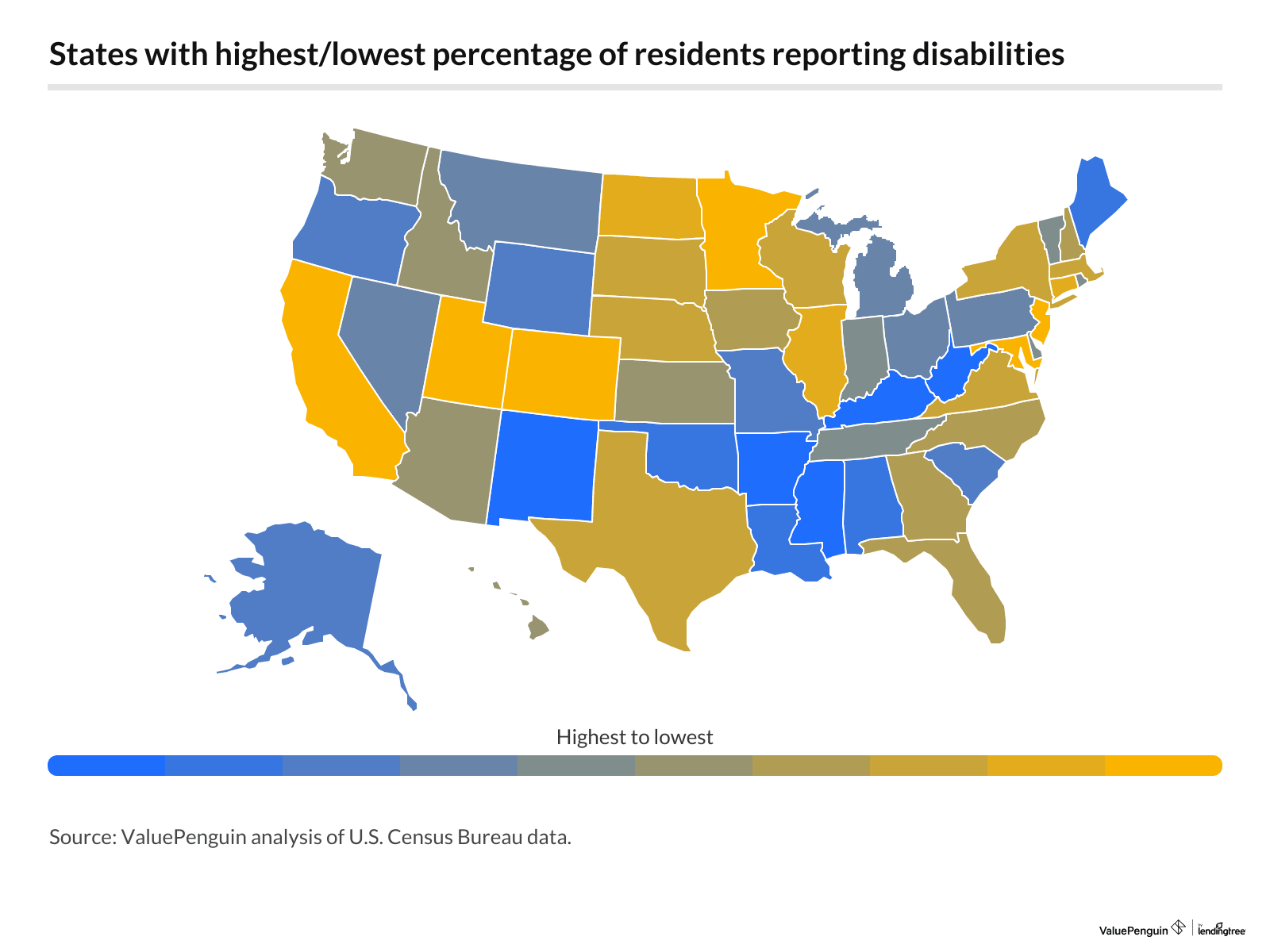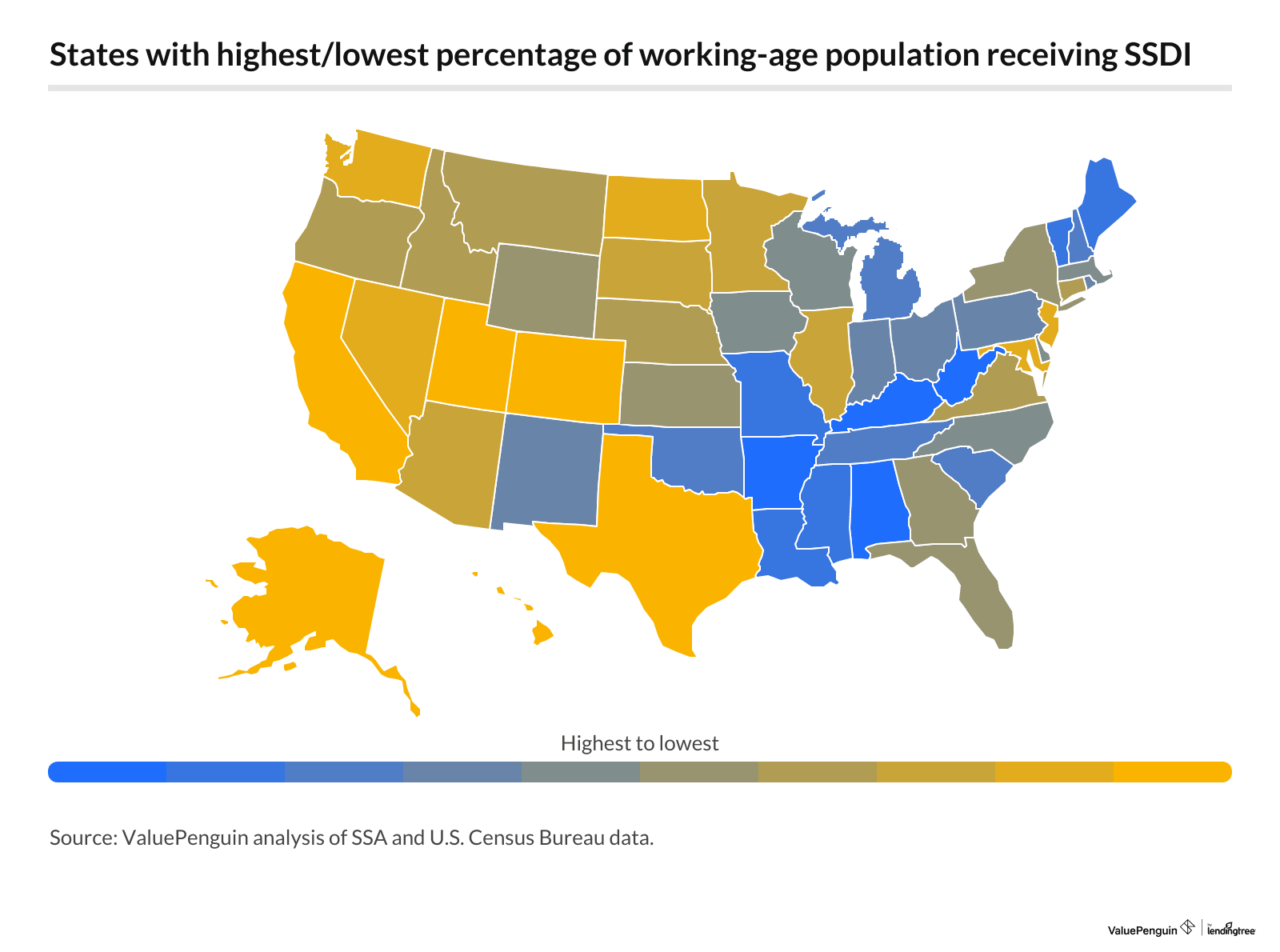Health Insurance
West Virginia Has Highest Disability Rate and Highest Percentage of Residents Receiving SSDI — Here’s Where Your State Lands

Disabilities impact millions of Americans’ daily lives. For those who can’t work because of a medical condition that’s expected to last at least one year or result in death, Social Security Disability Insurance (SSDI) can help them stay afloat.
According to the latest ValuePenguin study, 7.5 million disabled workers and spouses receive $11.4 billion monthly in SSDI benefits. Here’s what else we found.
On this page
Key findings
- 7.5 million disabled workers and spouses receive Social Security Disability Insurance (SSDI) monthly, totaling $11.4 billion in benefits. 14.0% of Americans report having a disability. The most common type of disability among those tracked is ambulatory (7.0%), or serious difficulty walking or climbing stairs. Independent living difficulty (6.3%) follows.
-
West Virginia has the highest percentage of residents with a disability. 19.5% of residents in the state report having a disability. Fellow Southern states Kentucky (18.1%) and Arkansas (18.0%) follow.
- West Virginia also has the highest percentage of the working-age (18 to 64) population receiving SSDI. 7.2% of this population in West Virginia gets disability insurance, at an average of $1,492 a month. Arkansas follows, with 6.6% receiving an average of $1,458. Kentucky rounds out the top three, at 6.4% and $1,482.
-
Just 2.0% of this population receives SSDI in Utah. That’s the lowest by state. California, Colorado and Hawaii follow, each at 2.2%.
Disabled workers, spouses receive $11.4B monthly in benefits
As of December 2023 (the latest beneficiaries data available), 7.5 million disabled workers and spouses receive Social Security Disability Insurance (SSDI) monthly. That amounts to $11.4 billion in benefits, mostly for disabled workers with a medical condition expected to last at least one year or result in death. (Spouses can receive SSDI if they’re 62 or older, or at any age if they care for a disabled child of the beneficiary younger than 16.)
ValuePenguin health insurance expert Divya Sangameshwar says SSDI is a financial lifeline that allows (to an extent) those with disabilities to maintain a basic standard of living despite their inability to work.
"The current payout may not fully cover recipients’ needs," she says. "While SSDI payments increase annually to reflect the rising cost of living, those cost-of-living adjustments (COLAs) aren’t sufficient."
In 2025, the COLA is just 2.5%, after increases of 3.2% in 2024 and 8.7% in 2023.
This comes as 14.0% of Americans report having a disability. Across the six disabilities we tracked, the most common form is ambulatory (7.0%), or having serious difficulty walking or climbing stairs. Independent living difficulty (6.3%), or being unable to do tasks or errands alone, follows.
Meanwhile, 6.1% of Americans have cognitive difficulties, 3.8% have hearing difficulties, 2.9% have self-care difficulties and 2.6% have vision difficulties.
West Virginia has highest disability rate
By state, West Virginia has the highest percentage of residents with a disability at 19.5%.
A major factor contributing to the high rate of disabilities here is its rural nature: According to the U.S. Census Bureau, disability rates are generally higher in rural areas. West Virginians also wrestle with poor health, having some of the highest rates of cardiovascular disease, cancer, diabetes and arthritis in the country.
States with highest percentage of residents reporting disabilities
Rank | State | % with disability |
|---|---|---|
| 1 | West Virginia | 19.5% |
| 2 | Kentucky | 18.1% |
| 3 | Arkansas | 18.0% |
Source: ValuePenguin analysis of U.S. Census Bureau data.
Kentucky and Arkansas residents have the next highest disability rates, at 18.1% and 18.0%, respectively. Both states are also significantly rural, likely contributing to their high rates. Both states also have some of the worst health outcomes, according to America’s Health Rankings, including some of the poorest physical health attributes (multiple chronic conditions, obesity, etc.) and high rates of behaviors like smoking and lack of physical activity.
Meanwhile, New Jersey and Utah tie for the lowest rate of residents with a disability, both at 10.9%. Maryland (11.6%) follows.

Full rankings
States with highest/lowest percentage of residents reporting disabilities
Rank | State | % with disability |
|---|---|---|
| 1 | West Virginia | 19.5% |
| 2 | Kentucky | 18.1% |
| 3 | Arkansas | 18.0% |
| 4 | Mississippi | 17.7% |
| 4 | New Mexico | 17.7% |
| 6 | Oklahoma | 17.4% |
| 7 | Louisiana | 17.2% |
| 8 | Alabama | 16.7% |
| 9 | Maine | 15.8% |
| 10 | Oregon | 15.3% |
| 11 | South Carolina | 15.2% |
| 12 | Alaska | 15.1% |
Source: ValuePenguin analysis of U.S. Census Bureau data.
West Virginia has highest rate of residents receiving SSDI
Perhaps unsurprising considering its high rate of residents with a disability, West Virginia also has the highest percentage of the working-age population receiving SSDI. (For our purposes, we compared a state’s number of disabled workers and spouses receiving SSDI to its 18-to-64 population; SSDI benefits turn to retirement benefits when you reach retirement age.) In West Virginia, 7.2% of the working-age population receives an average of $1,492 a month.
Not everyone who reports having a disability receives SSDI. The qualifications for receiving SSDI include working a certain number of years and paying Social Security taxes. Additionally, those who qualify may not follow through with the application process.
Arkansas — with 6.6% of this population receiving an average of $1,458 — and Kentucky — with 6.4% receiving an average of $1,482 — follow.
States with highest percentage of working-age population receiving SSDI
Rank | State | % receiving SSDI | Total monthly payments | Monthly payment per recipient |
|---|---|---|---|---|
| 1 | West Virginia | 7.2% | $110,806,000 | $1,492 |
| 2 | Arkansas | 6.6% | $175,687,000 | $1,458 |
| 3 | Kentucky | 6.4% | $255,963,000 | $1,482 |
Source: ValuePenguin analysis of Social Security Administration (SSA) and U.S. Census Bureau data. Note: The percentage receiving SSDI compares disabled workers and spouses who receive SSDI to the 18-to-64, or working-age, population.
Sangameshwar says the economies of states like West Virginia, Arkansas and Kentucky rely heavily on industries like coal mining, manufacturing and farming, which often result in workplace injuries and health issues that lead to disability claims. Additionally, lower educational attainment in these states makes it harder for individuals to transition to less physically demanding white-collar jobs if they develop health problems.
Conversely, just 2.0% of residents in Utah receive SSDI, at an average of $1,512. Though none of the following states is in the bottom three for lowest disability rates, California, Colorado and Hawaii all follow, at 2.2%.
When breaking it down by average monthly payments per recipient, New Jersey ranks first. Despite just 2.9% receiving SSDI, qualifying residents here receive $1,699 a month. Delaware — where 4.0% of residents receive $1,655 a month — and Nevada — where 2.9% of residents receive $1,612 a month — follow.
Meanwhile, those in the District of Columbia receive the smallest average monthly payments per recipient, with 2.4% receiving $1,376 a month. North Dakota (2.9% and $1,434) and Nebraska (3.3% and $1,435) follow.

Full rankings
States with highest/lowest percentage of working-age population receiving SSDI
Rank | State | % receiving SSDI | Total monthly payments | Monthly payment per recipient |
|---|---|---|---|---|
| 1 | West Virginia | 7.2% | $110,806,000 | $1,492 |
| 2 | Arkansas | 6.6% | $175,687,000 | $1,458 |
| 3 | Kentucky | 6.4% | $255,963,000 | $1,482 |
| 4 | Alabama | 6.3% | $287,848,000 | $1,495 |
| 5 | Mississippi | 6.2% | $156,491,000 | $1,451 |
| 6 | Maine | 5.9% | $70,048,000 | $1,441 |
| 7 | Missouri | 5.1% | $275,956,000 | $1,482 |
| 8 | Louisiana | 5.0% | $198,497,000 | $1,455 |
| 8 | Vermont | 5.0% | $27,823,000 | $1,443 |
| 10 | Michigan | 4.9% | $455,273,000 | $1,549 |
| 10 | Tennessee | 4.9% | $314,629,000 | $1,489 |
| 12 | Oklahoma | 4.8% | $169,524,000 | $1,462 |
Source: ValuePenguin analysis of SSA and U.S. Census Bureau data. Note: The percentage receiving SSDI compares disabled workers and spouses who receive SSDI to the 18-to-64 population.
Applying for disability insurance: Top expert tips
"Life can be uncertain, and we could easily be unable to work or earn a living due to a disability," Sangameshwar says. "While programs like SSDI or workers compensation insurance could provide some income, the money you’ll get from these programs may not be enough to make ends meet in the case of long-term disability."
For those who can afford to, Sangameshwar says planning for a future disability should be part of your financial planning. "This includes getting a disability insurance policy," she says. "Your employer may offer you disability insurance at a low cost, but you’ll need to check what type of policy they offer. If it’s a short-term disability policy, you’ll only get paid for a limited amount of time, like a year. Even if your employer offers a long-term disability plan, benefits will end a few years after you retire."
Purchasing a disability insurance policy on your own may be a bit more expensive since premiums will be based on factors like age, health and occupation. However, it’ll give you an additional source of income if you lose your ability to work due to a qualifying disability. While most personal long-term disability policies will pay out until retirement age, you can opt for a policy that pays out for a longer period or the rest of your life. Meanwhile, long-term care (LTC) insurance may be another option for those who qualify.
Finally, those who qualify for SSDI may also be eligible for Medicare — even if they’re younger than 65 — after a 24-month waiting period (with some exceptions).
Methodology
ValuePenguin researchers analyzed Social Security Administration (SSA) and U.S. Census Bureau data.
First, analysts compared U.S. Census Bureau data for population and population with a disability to calculate the percentage of residents reporting disabilities in the 50 states and the District of Columbia.
Second, analysts compared the number of disabled workers and spouses receiving Social Security Disability Insurance (SSDI) to the working-age population, 18 to 64.
Data comes from "OASDI Beneficiaries by State and County, 2023" for December 2023 and the U.S. Census Bureau 2023 American Community Survey with one-year estimates.
